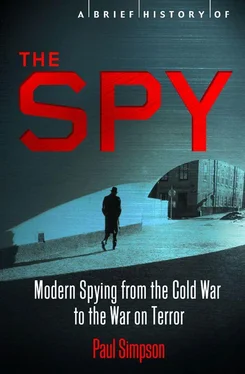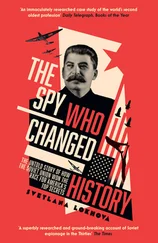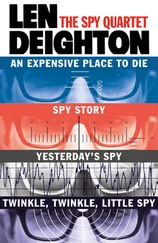Paul Simpson - A Brief History of the Spy
Здесь есть возможность читать онлайн «Paul Simpson - A Brief History of the Spy» весь текст электронной книги совершенно бесплатно (целиком полную версию без сокращений). В некоторых случаях можно слушать аудио, скачать через торрент в формате fb2 и присутствует краткое содержание. Город: London, Год выпуска: 2013, ISBN: 2013, Издательство: Constable & Robinson, Жанр: Прочая документальная литература, на английском языке. Описание произведения, (предисловие) а так же отзывы посетителей доступны на портале библиотеки ЛибКат.
- Название:A Brief History of the Spy
- Автор:
- Издательство:Constable & Robinson
- Жанр:
- Год:2013
- Город:London
- ISBN:9781780338910
- Рейтинг книги:3 / 5. Голосов: 1
-
Избранное:Добавить в избранное
- Отзывы:
-
Ваша оценка:
- 60
- 1
- 2
- 3
- 4
- 5
A Brief History of the Spy: краткое содержание, описание и аннотация
Предлагаем к чтению аннотацию, описание, краткое содержание или предисловие (зависит от того, что написал сам автор книги «A Brief History of the Spy»). Если вы не нашли необходимую информацию о книге — напишите в комментариях, мы постараемся отыскать её.
A Brief History of the Spy — читать онлайн бесплатно полную книгу (весь текст) целиком
Ниже представлен текст книги, разбитый по страницам. Система сохранения места последней прочитанной страницы, позволяет с удобством читать онлайн бесплатно книгу «A Brief History of the Spy», без необходимости каждый раз заново искать на чём Вы остановились. Поставьте закладку, и сможете в любой момент перейти на страницу, на которой закончили чтение.
Интервал:
Закладка:
Rather than use a poisoned jelly rubbed on Markov’s skin (which was tried unsuccessfully on another émigré), or a poison within his food, the KGB scientists decided to use a small ball containing ricin, which was derived from castor plant seeds. They created a pellet and inserted it in the tip of a specially modified umbrella — bought by the KGB residency in Washington, its American origins designed to place the Soviets one step further removed from the operation — and given to the agent chosen. Although there is some question over this, it is generally believed that Francesco Giullino, a Dane of Italian extraction who had been recruited as an agent in 1970, was responsible.
On 7 September 1978, as he was waiting at a bus stop on Waterloo Bridge in London to head to the BBC radio headquarters, Bush House, Markov felt a sting in his thigh. Turning, he saw a stranger pick up an umbrella he had apparently dropped, then get in a taxi. That night Markov fell dangerously ill, and he died in hospital on 11 September.
A post-mortem examination by scientists at the Chemical Defence Establishment at Porton Down discovered the metal pellet that had contained the poison, but none had survived contact with Markov’s blood stream. A process of elimination resulted in the deduction that ricin had been involved, based on the symptoms Markov presented and the toxicity of the tiny dose that the pellet would have contained. Another émigré, Vladmir Kostov, had been similarly attacked in Paris, but the pellet had failed to release the ricin.
Reeling from the effects of the various Congressional committees, the CIA underwent a period of retrenchment and reorganization in the late seventies. It was under considerably more scrutiny than previously. A new broom was required, and, as the CIA’s own description of William Colby’s replacement George H.W. Bush points out, ‘Having as DCI a politically skilled leader who had served in Congress fit the unprecedented circumstances of the moment.’
Future president Bush senior was appointed as DCI in November 1975, and served until the arrival of the Carter administration in January 1977. Bush was not a career spy: ‘I walked in [to the CIA in 1975] untutored in the arts of intelligence,’ he recalled when opening the George Bush Center for Intelligence in 1999. ‘You had every reason to be suspicious of this untutored outsider who had, though he came out of a non-political post in China, spent a lot of my time in partisan politics. I understood the anxiety and concerns on Capitol Hill about that. But this Agency gave me their trust from Day One.’
President Ford issued new executive orders that created a new command structure for foreign intelligence-gathering and was described by the White House as ‘the first major reorganisation of the Intelligence Community since 1947’. He also imposed a specific ban on assassinations. A new Senate Select Committee on Intelligence was established, followed by a House committee during President Carter’s tenure.
However, the new president brought in Admiral Stansfield Turner as DCI, who proved to be a divisive head, emphasizing technical intelligence and SIGINT over agents in the field. The ‘Halloween massacre’ in which 82 °CIA employees were given notice was Turner’s way of continuing the house clearing that had actually begun under James Schlesinger back in 1973, but this was far more drastic. Described as insensitive by some Agency observers, this saw 147 career officers take early retirement, seventeen sacked, and most of those who had served since the OSS days and the institution of the CIA in 1947 removed. Turner himself would come to regret the action: ‘In retrospect, I probably should not have effected the reductions of 820 positions at all, and certainly not the last 17,’ he wrote in 2005.
Although analysts and electronic intelligence would form the backbone of Turner’s plans for the Agency, the CIA still used and needed spies. Dimitri Polyakov continued to be a highly effective asset for the Agency within the GRU until 1980, despite his cover being blown by traitorous FBI agent Robert Hanssen a year earlier when he first made contact with Soviet intelligence; the GRU simply refused to believe that such a high-ranking officer would commit treason. When Polyakov realized he was being investigated, he chose, albeit reluctantly, to retire.
Another recruit, Alexsandr Ogorodnik, would turn out to be one of the CIA’s most useful agents within the Soviet Union itself, while the identity of his handler in Moscow would surprise many working for the KGB.
Ogorodnik was recruited while stationed in the Soviet Ministry for Foreign Affairs in Bogotá, Colombia, in 1973. His dislike of the Soviet system, combined with a taste for the high life, as well as complications with his local mistress, made him a good choice as a spy. Rapidly trained in tradecraft before his recall to Moscow, Ogorodnik was provided with the latest in miniature cameras, the T-50. This was only an inch and a half long and three-eighths of an inch in diameter, and could shoot up to fifty exposures on its fifteen-inch film. Ogorodnik, now code-named Trigon, was given the camera within an expensive-looking pen, supplied to the CIA by a leading manufacturer working under secret contract.
Trigon’s first assignment occurred while he was still in Bogotá, photographing a Soviet policy paper on China — the first time that a CIA agent had ever been able to do this within a Soviet residency. According to then-Secretary of State Henry Kissinger, it was ‘the most important piece of intelligence he had read’ while in office.
Ogorodnik was recalled to Moscow in 1975, and insisted on receiving a suicide pill from the CIA before he left. This was reluctantly agreed to by senior officials at Langley and concealed within another pen. Once back in the Soviet Union, Ogorodnik was subject to the usual scrutiny that any returning diplomat received from the KGB, but once this had become less rigorous, he began working for the CIA once more.
His handler was Martha D. Peterson, who became known as ‘The Widow Spy’, the first female CIA case officer ever posted to Moscow. The KGB used very few women as spies — they were useful as bait for honey traps or if they were already in position as secretaries with access to confidential material, but at various times there were specific prohibitions within the KGB against their recruitment as agents — so didn’t consider that Peterson could be there as a CIA handler.
In spring 1977, communications between Peterson and Trigon broke down, and the Soviet failed to respond to a request for a meeting. However, there was a reply to an alternate signal, which indicated that Trigon would collect a package at a predetermined spot. On 15 July, Peterson headed to the Krasno Gluhovsky Bridge crossing the Moskva River and filled the dead drop with material for Trigon. As she left, she was arrested and taken to the Lubyanka for questioning. After a short time, she was released because of her diplomatic immunity, declared persona non grata and thrown out of the country.
Trigon was already dead. Karl Koecher had seen documents that indicated that a Soviet diplomat was working for the CIA, and informed the KGB. They had carried out a lengthy investigation, and eventually arrested Ogorodnik. He agreed to write a confession, but asked to use his own pen, as the interrogator’s was too clumsy. Swiftly he removed the capsule, and was able to kill himself before the guard in the interrogation room could stop him.
MI6 were also running an agent within the Soviet Union by this stage. Oleg Gordievsky, whose files on the KGB would prove to be a treasure trove of information when he eventually defected, signed up in 1974. Embittered by the actions of the KGB during the Prague Spring in 1968, he noted in his autobiography that ‘Until the early 1970s I clung to the hope that the Soviet Union might still reject the Communist yoke and progress to freedom and democracy.’ He told the BBC in 2009, ‘I was approached by MI6 but in a way I provoked that approach. I realised slowly that this was a state that was worse than Hitler’s Germany.’ Gordievsky was stationed in Denmark at the time and would become as useful to the West as Oleg Penkovsky had been in the previous decade — particularly when he was posted to London as the KGB resident in 1982.
Читать дальшеИнтервал:
Закладка:
Похожие книги на «A Brief History of the Spy»
Представляем Вашему вниманию похожие книги на «A Brief History of the Spy» списком для выбора. Мы отобрали схожую по названию и смыслу литературу в надежде предоставить читателям больше вариантов отыскать новые, интересные, ещё непрочитанные произведения.
Обсуждение, отзывы о книге «A Brief History of the Spy» и просто собственные мнения читателей. Оставьте ваши комментарии, напишите, что Вы думаете о произведении, его смысле или главных героях. Укажите что конкретно понравилось, а что нет, и почему Вы так считаете.












